| My Life in Kazakhstan |
| While I was working on my Master's
degree, I met a beautiful young lady. I decided to follow her back to her country
after completing my degree. I took my Master's degree in economics and traveled half way
across the world. It was quite an adventure. I was lucky and found a job with the
Kazakhstan Institute of Management, Economics, and Strategic Research. This institute was the former Communist institute
where Kazakh citizens could learn about Communism. When the Republic of Kazakhstan receded
from the Soviet Union, this facility became vacant. In 1992, President Nazerbayev donated
this facility and it became a Western business school. In the beginning, all the
professors were from Western Europe and the United States. I had a great time there and
regretted my decision to resign. Most of the students were engineers, mathematicians, and
scientists. They were eager to change careers and study business. |
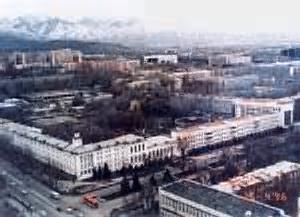
This is the Kazakhstan Institute of Management,
Economics, and Strategic Research.
|
|
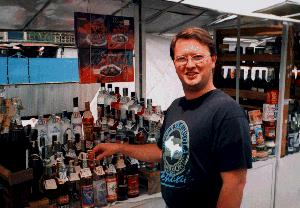
I am shopping at a bazar, which is an outdoor
merchant's market. This merchant was selling liquor.
|
|
Republic of
Kazakstan
- Area of the country spans 1,049,155 square miles.
- The currency is the tenge.
- The capitol is Almaty, but will be moved to Akhmola
by Year 2000.
- In 1994, the population was estimated at 17,267,564.
- This country has extensive mineral resources, such as
coal and petroleum and also produces cement, iron, steel, fertilizers, and texiles.
- The leading space agency is the Baikonur
Cosmodrome. Russia still has its space program located there.
- Kazaks comprise of 43.2% of the population with
Russian comprising 36.5%. There are racial tensions between the two groups.
- 60% of the population live in cities.
- The USSR tested its nuclear weapons in this country.
|
|
| When I first arrived, I had major
adjustment problems. Their living standard is half the United States. Early in the
morning, I had to go in the courtyard to buy milk from a big aluminum container in a car
trunk. Then I took it home and gently heated the milk on the stove to pastuerize it.
Processed foods were hard to find, because many families prepared meals from scratch. The
stores tend to be dirty looking, the clerks are rude, and the stores have very little
variety. Instead, I would shop at a bazar, which is a open market. Merchants sell their
goods on small tables and literally you could walk for miles, looking at merchandise. |
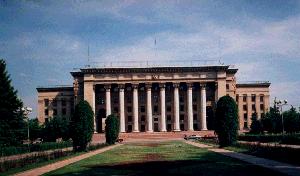
This is the Parliment Building of Kazakhstan.
|
|
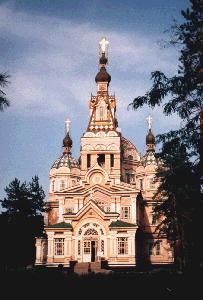
This is a Russian Orthodox church. The inside
is very beautiful with murals painted on every wall. Russian churchs do not have pews;
everyone stands for the service.
|
|
I lived in the capital Amaty for exactly
two years. During this time, I was witnessing changes. The post-Soviet companies formed
partnerships with Western businesses. Products and services were becoming better.
Processed foods were being produced locally. Some products were shipped in from other
countries and I acquired a taste for certain products. I miss Iranian pickles and tomatoe
paste, French hotdogs, Holland beer, and German jams |
| Some remants of Soviet culture remained.
Contrary to popular belief, Communism was not all bad. The Soviet Union achieved almost a
100% literacy rate. Books and magazines were sold at kiosks on every street corner. The
Soviets built beautiful zoos, parks, ballet theaters, concert halls, and government
buildings. Even when I was there, a person could buy a ticket to a classical music concert
for a $1. However, all the people lived in identical apartment buildings. In Almaty, the
majority of the apartment buildings were 4 stories tall and white. It is quite confusing
to walk block after block and see the same buildings, but the ironical thing is ethnic
groups were blended together well. This is not like America, where large cities would have
a neighborhood of the same ethnic group. |



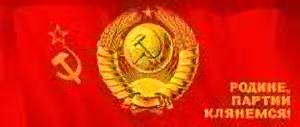
In small towns, you can still see Soviet
insignia. This banner says "We give allegiance to the Homeland and Party," while
the pin above says "Lenin."
|
|
Links for this page!
|







